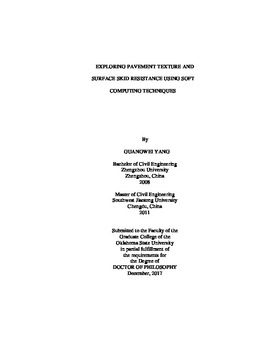| dc.contributor.advisor | Li, Qiang | |
| dc.contributor.author | Yang, Guangwei | |
| dc.date.accessioned | 2018-06-25T13:38:34Z | |
| dc.date.available | 2018-06-25T13:38:34Z | |
| dc.date.issued | 2017-12 | |
| dc.identifier.uri | https://hdl.handle.net/11244/300274 | |
| dc.description.abstract | Pavement skid resistance and texture characteristics are important aspects of road safety. Traditional pavement friction measurement from limited contact with pavement is influenced by multiple factors such as temperature, water depth, and testing speed. Friction prediction from texture data has a potential to save resources and reduce inconsistence of friction measurement due to the existence of water and rubber in friction data collection. This dissertation investigates the application of pavement 2-dimensional /3-dimensional (2D/3D) texture data for friction evaluation from different perspectives. | |
| dc.description.abstract | 3D texture data with ultra-high resolution 3D laser scanner and friction data with Dynamic Friction Tester are collected on the Long Term Pavement Performance (LTPP) Specific Pavement Study 10 (SPS-10) site in Oklahoma. 2D macro-texture data with High Speed Profiler and friction data with Grip Tester are measured on 49 High Friction Surface Treatment (HFST) sites scattered in 12 states in the United States. | |
| dc.description.abstract | Firstly, novel 3D parameters, rather than traditional texture indicators, are calculated for 3D texture data to identify the most important and appropriate texture parameters for skid resistance evaluation. Pavement friction models including the identified 3D texture parameters are developed with fairly good accuracy. | |
| dc.description.abstract | Secondly, the wavelet and deep learning methodologies are employed to better use 2D macro-texture data. Discrete wavelet transform is implemented to decompose 2D macro-texture data, which are collected on six HFST sites in Oklahoma, into multiple wavelengths. The Total Energy and Relative Energy are calculated as indicators to represent macro-texture characteristics at various wavelengths. A robust non-contact friction prediction model incorporating energy indicators is proposed with good accuracy. In addition, FrictionNet, a Convolutional Neural Network based model, is developed to pairwise relationship between pavement texture and friction using 2D macro-texture profile as a whole. 49 HFST sites distributed in the 12 states are surveyed including various types of lead-in and lead-out pavement sections. The FrictionNet achieves high accuracy for training, validation, and testing in friction prediction. | |
| dc.description.abstract | In summary, novel 3D texture parameters for 3D texture data are identified, and new computing technologies are implemented to better use 2D macro-texture data with respect to pavement friction evaluation. The results demonstrate the potential of using non-contact texture measurements for pavement friction evaluation. | |
| dc.format | application/pdf | |
| dc.language | en_US | |
| dc.rights | Copyright is held by the author who has granted the Oklahoma State University Library the non-exclusive right to share this material in its institutional repository. Contact Digital Library Services at lib-dls@okstate.edu or 405-744-9161 for the permission policy on the use, reproduction or distribution of this material. | |
| dc.title | Exploring pavement texture and surface skid resistance using soft computing techniques | |
| dc.contributor.committeeMember | Wang, Chenping | |
| dc.contributor.committeeMember | Cross, Stephen A. | |
| dc.contributor.committeeMember | Teague, Keith A. | |
| osu.filename | Yang_okstate_0664D_15460.pdf | |
| osu.accesstype | Open Access | |
| dc.type.genre | Dissertation | |
| dc.type.material | Text | |
| thesis.degree.discipline | Civil Engineering | |
| thesis.degree.grantor | Oklahoma State University | |
